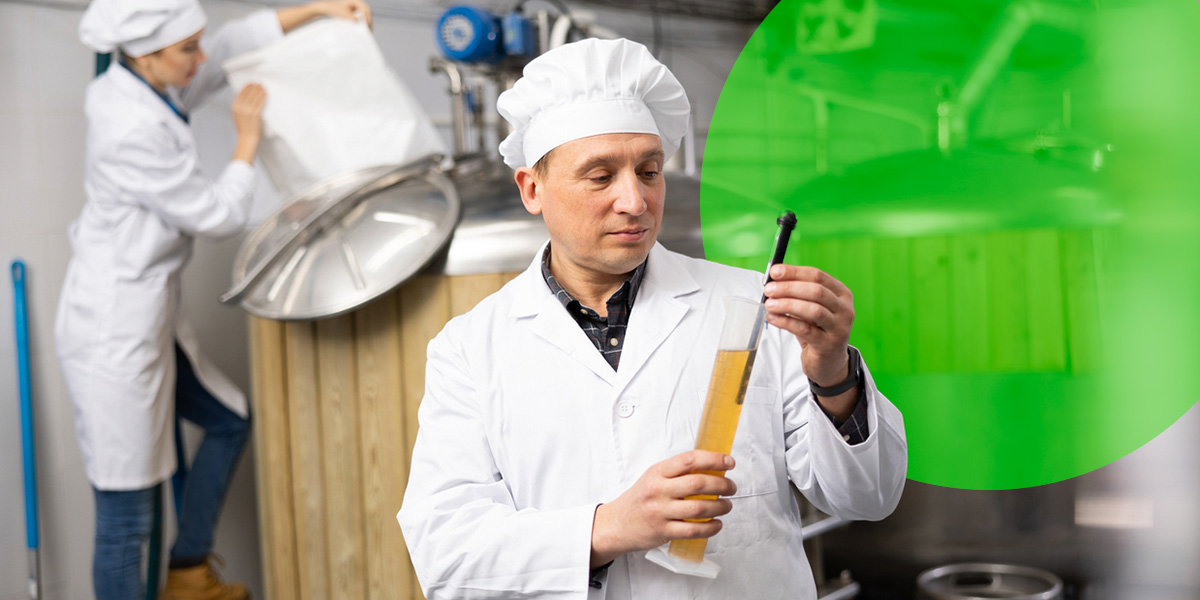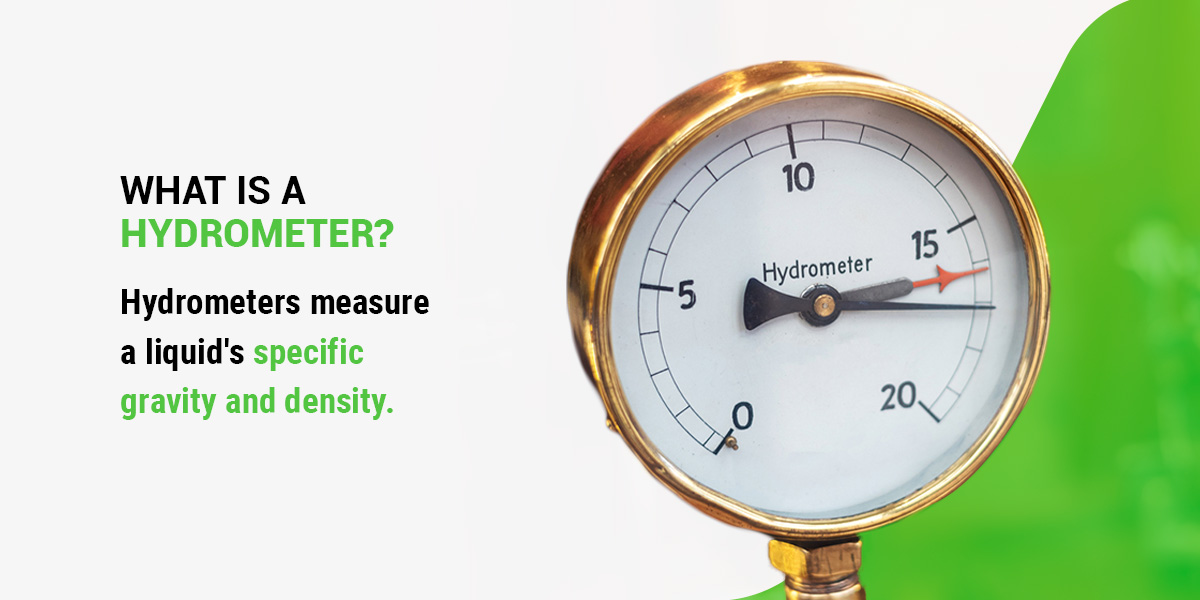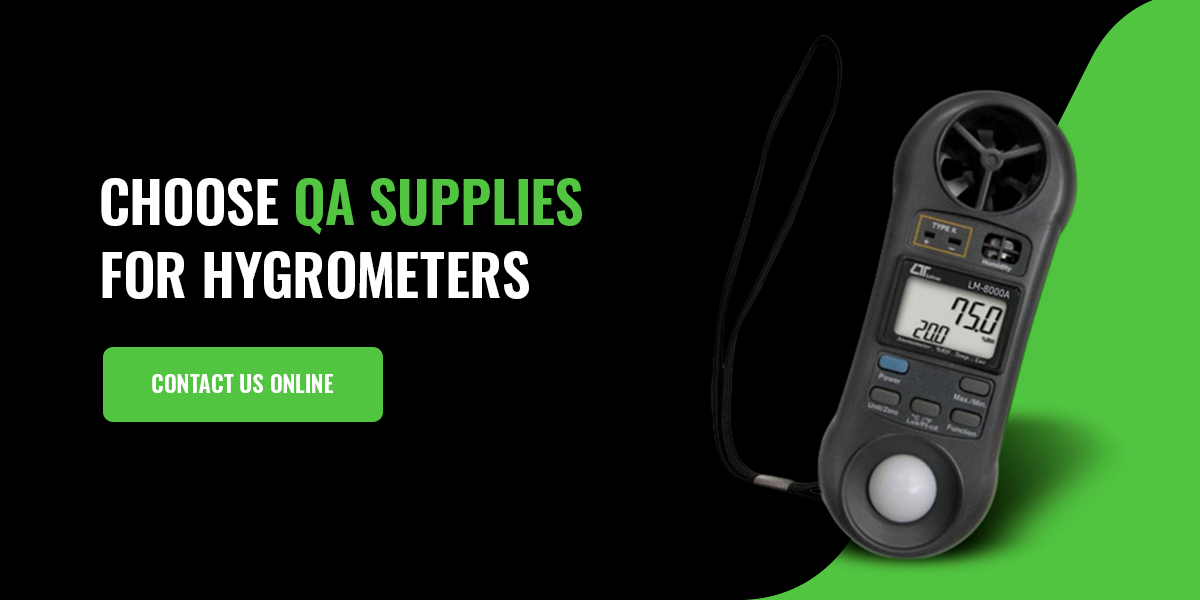Hygrometer vs. Hydrometer
Apr 26th 2023

- What Is a Hygrometer?
- What Does a Hygrometer Measure?
- How Does a Hygrometer Work?
- How to Use a Hygrometer
- What Is a Hydrometer?
- What Does a Hydrometer Look Like?
- How Does a Hydrometer Work?
- The Difference Between Hygrometers and Hydrometers
- Choose QA Supplies for Hygrometers
Hygrometers and hydrometers are two measuring instruments used in several industries to help with quality control and consistency. The food industry relies on tools like hydrometers and hygrometers to maintain standards throughout their production process. Without high-quality measuring tools, ensuring their products retained the correct standards and quality would be much more difficult.
While they serve different purposes, both enhance the quality and consistency of the food and beverage industry's products. Understanding the differences between hygrometers vs. hydrometers allows you to evaluate the quality control process better and refine it for more precise standards and problem-solving techniques.
What Is a Hygrometer?
Hygrometers measure the humidity in the air. Humidity is the water vapor floating all around us — the more water in the air, the higher the humidity. There are lots of different hygrometers that each use a slightly different method to measure humidity. The measurement device will record evaporation rates, tension adjustments or other environmental changes to track the changing humidity. Its basic form is extremely old, but modern technology has allowed for more complex, accurate hygrometer development.
What Does a Hygrometer Measure?
Hygrometers measure humidity. Combination thermometers and hygrometers, or thermo-hygrometers, track an environment's temperature and humidity. Measuring these conditions ensures facilities keep their products at the right temperature and humidity. If conditions become too humid or warm, food can spoil, separate or mold. Without constant monitoring, facilities would see higher spoilage rates and wasted products. Ensuring your facility has accurate hygrometers can save you significant amounts of product and money long-term.
How Does a Hygrometer Work?
All hygrometers measure humidity, although they might use a slightly different method to achieve their results. A psychrometer is a popular type of hygrometer that has two thermometers. One thermometer, the wet-bulb thermometer, has one end wrapped in a damp cloth. The other dry-bulb thermometer has its end exposed to the air. The wet-bulb thermometer reads cooler since it has the wet cloth on it — the rate of evaporation from the cloth depends on the humidity. You get the humidity reading by combining the warmer dry-bulb measurements and cooler wet-bulb measurements.
How to Use a Hygrometer
Hygrometers are less involved to use than hydrometers. Since they take the readings for you using thermometers, changes in resistivity or hair tension, you simply need to attach them to the desired location or hold them in the area you want to measure. Once in place and activated, they will measure the humidity and provide you with a reading. Handheld hygrometers do not take long to get a reading from, while others — like psychrometers — can take up to several hours to produce the complete reading.

What Is a Hydrometer?
Hydrometers measure a liquid's specific gravity and density. Specific gravity is a measurement that lets you know how the weight of a liquid compares to an equal amount of water. Density tells you the quantity of something per volume — the denser the liquid, the more an object will float. Something like water is less dense, making it easier for the measuring device to sink, while a liquid like milk has water and other components that make it denser and easier for the device to float in.
What Does a Hydrometer Look Like?
Hydrometers consist of a small plastic or glass tube with a scale measuring specific gravity. One end is bulb-shaped with a steel or fin lead shot inside. This weight — or ballast — allows the hydrometer to float upright in a liquid. The hydrometer is placed in the sample liquid, and the spot on the scale that lines up with the liquid level tells you the liquid's specific gravity.
Additionally, hydrometers can be calibrated from different scales to measure other chemicals. Hydrometers can measure:
- Alcohol percentage by weight
- Pure sugar by weight
- The salt content in a solution
- Petroleum liquid densities
Different hydrometers will have different names depending on their measurement area. Since they come with several specialized options, make sure you're selecting the right hydrometer for the job. Know what you want to test and find the correct hydrometer for the job.
How Does a Hydrometer Work?
Using a hydrometer is straightforward. Simply place the hydrometer in a hydrometer jar with the liquid you wish to measure. Then, note the lowest point of the liquid's surface. Write down the measurement of the spit where the liquid's surface touches the hydrometer. Finally, check the solution temperature. The solution temperature should be the same as your hydrometer — if not, use the manufacturer's temperature correction table to adjust everything correctly.
The Difference Between Hygrometers and Hydrometers
The core difference between hygrometers and hydrometers is what they measure — hygrometers measure humidity, and hydrometers measure specific gravity, which tells you a liquid's density. Each device is a valuable tool for quality control and product monitoring, but they test different production areas.
Hygrometers are used throughout production and transport to ensure each area maintains the correct temperature and humidity levels. Many food and beverage products rely on their environment remaining cold with low humidity levels to protect them from mold, bacteria growth and separation. The hygrometer allows you to measure temperature and humidity in a given space by affixing it to a wall or carrying a portable device for on-the-go measuring.
Hydrometers are often used in the food and beverage industry for winemaking and brewing. Saccharometers — specialized hydrometers — check the wines' sugar content. A wine's sugar content directly affects its alcohol content, an essential aspect of every wine. Additionally, alcoholometers can measure a liquid's alcohol content, affecting the product of breweries and wineries.
Hygrometers and hydrometers are used differently to help with ensuring food and beverage products come out as desired. Without humidity and specific gravity measurements, facilities would not produce products that matched the level of quality or the different compositions they wanted.
Choose QA Supplies for Hygrometers
QA Supplies carries high-quality, portable hygrometers for better, more accurate humidity readings. Our durable instruments allow you to carefully monitor humidity levels to prevent spoilage and waste at your facility and during transport. We carry min-max hygrometers and psychrometers so you can find the right option for your needs. Choose from several models and get lasting, reliable hygrometers for an improved quality control experience.
If you're interested in getting the best harvesting, monitoring and inspection supplies for your company, check out our products today. Our on-site calibration laboratory ensures your instruments are up to standard so you can take the stress of accuracy off your shoulders. If you have any questions or want to know more about our products, contact us online to learn more.


